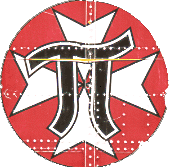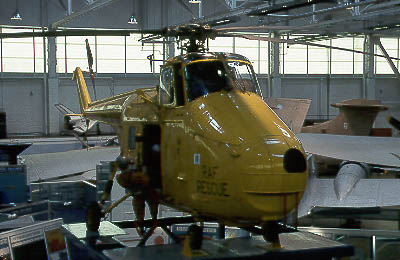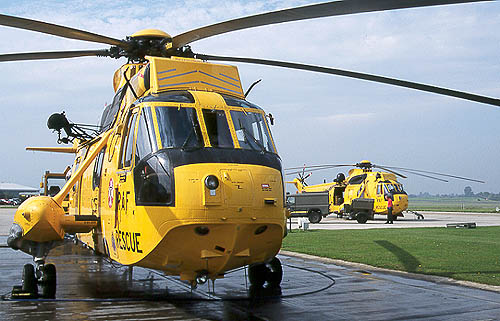Home | Airshows | The Hangar | Nostalgia | Links
Wattisham Squadrons
22 Squadron, Easy as Pi! by Dave Eade
 Renowned today for its yellow painted Air-Sea Rescue
Sea Kings, the squadron was born into a very different field of aeronautics.
Founded at Gosport in Hampshire from a core of 13 Squadron in 1916, the
early role was one of Army Co-operation and fighter sweeps over France
in 1917, using a myriad of aircraft ranging from the Longhorn to the Bristol
F2b. At the end of hostilities the squadron was disbanded at Croydon.
Renowned today for its yellow painted Air-Sea Rescue
Sea Kings, the squadron was born into a very different field of aeronautics.
Founded at Gosport in Hampshire from a core of 13 Squadron in 1916, the
early role was one of Army Co-operation and fighter sweeps over France
in 1917, using a myriad of aircraft ranging from the Longhorn to the Bristol
F2b. At the end of hostilities the squadron was disbanded at Croydon.
Martlesham Heath, home of RAF Experimental Flying, was to be the Squadron home for 11 years following reformation in 1923. Although no aircraft were permanently assigned to the unit, test flying on Gamecocks, Turcocks, Bulldogs and Jockeys was carried out until finally the squadron was equipped with Vickers Vilderbeest, disbanding and re-forming the same day at Donibristle in Fife, on 1 May 1934. Test flying had led to the squadron pilots receiving two AFCs and a record non-stop flight from Cranwell to Karachi.
 The Abyssinian crisis in 1935
saw the unit posted to Malta, and at the outbreak of the Second World
War was equipped with Beauforts. It was at this time that the squadron
badge was first seen. The badge consists of the Greek letter pi on a
Maltese cross. When taking off in a certain direction the squadron (22)
had to fly over the Group HQ (7). Hence, 22 over 7 = pi.
The Abyssinian crisis in 1935
saw the unit posted to Malta, and at the outbreak of the Second World
War was equipped with Beauforts. It was at this time that the squadron
badge was first seen. The badge consists of the Greek letter pi on a
Maltese cross. When taking off in a certain direction the squadron (22)
had to fly over the Group HQ (7). Hence, 22 over 7 = pi.
Flying initially from North Coates in Lincolnshire, and later from St. Eval in Cornwall, missions credited included raids against the Scharnhorst and Gneisenau in April 1941 for which further honours were bestowed on the squadron, with the award of a posthumous Victoria Cross to F/O Kenneth Campbell. The operation started badly as heavy rain had rendered St. Eval a quagmire and only three of the six available aircraft got airborne; only two, that of Campbell and Flt Lt Hythe, made it to the target. As it became light Campbell decided to press home the attack and made his approach, successfully dropping his torpedo just before heavy flak hit the Beaufort, causing it to crash immediately into the harbour. The Gneisenau was out of action for eight months, but it was not until March 1942 that Campbell's heroics were known to the authorities in London, his VC awarded shortly after.
1942, the Far East beckoned for 22, and the tour equipped now with Beaufighters included operations in 1945 against the Japanese in Burma.
The end of these hostilities led again to disbandment, although only for a short while before the squadron re-appeared at a Mosquito Squadron at Seletar, in Germany with the 2 TAF. Only reformed for four months, a long period of rest followed before 22 assumed a role for which it is still renowned today.
 February 1955 brought
activation at Thorney Island with the first of a long line of Air-Sea
Rescue helicopters, which the squadron has executed this role in turn,
commencing with Sycamore, Whirlwind, Wessex and finally Sea Kings. Future
moves would see the squadron based at St. Mawgan and Finningley, with
up to three 'flights' detached at Valley, Felixstowe, Tangmere, Martlesham
Heath, Manston, Coltishall, Leuchars, Finningley, Leconfield, Chivenor,
Brawdy and even Christmas Island, in the Pacific.
February 1955 brought
activation at Thorney Island with the first of a long line of Air-Sea
Rescue helicopters, which the squadron has executed this role in turn,
commencing with Sycamore, Whirlwind, Wessex and finally Sea Kings. Future
moves would see the squadron based at St. Mawgan and Finningley, with
up to three 'flights' detached at Valley, Felixstowe, Tangmere, Martlesham
Heath, Manston, Coltishall, Leuchars, Finningley, Leconfield, Chivenor,
Brawdy and even Christmas Island, in the Pacific.
As Wattisham faced the end of its 'career' as a fighter station, and the pending arrival of the Army Air Corps, one last link with the Royal Air Force was put in place B Flight of 22 Squadron was moved here. This was seen as a somewhat controversial move by many, as the increased range of the Sea King over the Wessex did not seem to compensate for the area that the Flight was expected to cover. At the expense of equipping Wattisham with Sea Kings, two Wessex were lost from both Coltishall in Norfolk and Manston in Kent. This means that, at first glance, an area from the beaches of the Wells-next-the Sea on the southern side of the Wash to Eastbourne on the Sussex coast are subject to the rescue services of two aircraft. However this is not the whole picture, as rescue services tend to be very co-ordinated not only within the UK but the Dutch, Belgian and French units are on hand as well. A recent mission involved the Wattisham Sea King being in action on the Norfolk coast, and being required at a road-traffic accident in Kent at the same time. A quick look at the atlas shows that the Belgian Sea Kings from Koksijde were, in fact, nearer to the accident than the RAF resulting in a scramble for the Belgians and perhaps a shock for the victims on being rescued by a camouflaged helicopter with a distinctly Belgian accent.
 In a recent visit to Wattisham, your scribe
had the opportunity to discuss the status of B Flight with one of the
pilots, Flt Lt Chris Risley. During the day the unit is on fifteen minutes
readiness, although most scrambles are effected in ten. At night the time
goes out to foty-five minutes, with the crews allowed sleeping, still
in their flying overalls. Crews are on duty for a twenty-four hour shift,
and responsible for their own cooking. Equipped with the latest mark of
Sea King, the HAR3A, it is possible to fly from take-off to a GPS
controlled reference point somewhere in the North Sea and go to the
hover immediately above a stricken vessel without touching the controls.
Easy as Pi! But, it is somewhat galling to the aircrew that the helicopter
will hover better on automatic than the most experienced Mk.1 pilot can
manage. It is ironic that this latest form or "alert" should be on the
very location of the old QRA hangars of days gone by.
In a recent visit to Wattisham, your scribe
had the opportunity to discuss the status of B Flight with one of the
pilots, Flt Lt Chris Risley. During the day the unit is on fifteen minutes
readiness, although most scrambles are effected in ten. At night the time
goes out to foty-five minutes, with the crews allowed sleeping, still
in their flying overalls. Crews are on duty for a twenty-four hour shift,
and responsible for their own cooking. Equipped with the latest mark of
Sea King, the HAR3A, it is possible to fly from take-off to a GPS
controlled reference point somewhere in the North Sea and go to the
hover immediately above a stricken vessel without touching the controls.
Easy as Pi! But, it is somewhat galling to the aircrew that the helicopter
will hover better on automatic than the most experienced Mk.1 pilot can
manage. It is ironic that this latest form or "alert" should be on the
very location of the old QRA hangars of days gone by.
In early 1999 the unit had been scrambled more than 100 times, and surprisingly only once for their prime role the rescue of downed MILITARY aircrew. The general run of scrambles involves RTAs and similar urgent hospital runs coupled with the occasional transplant flight. More often than not, this can involve collecting the staff who perform such operations as well as the organ! Chris Risley was quick to point out, however, that the buzz of a military call is special those are not the ones to get wrong!
Overall management of any rescue comes under the control of the Rescue Co-ordination centre in Kinloss who generate some 2000 scrambles a year. The success rate of the system is obvious when one looks at the figures for the first quarter of 1999 Calls = 477: People carried = 336.
To a downed airman, sick seaman, or a child on a misplaced lilo, the sight of a yellow Sea King can only bring the greatest feeling of relief. Some may argue that, since the end of the second world war, the presence of No. 22 at Wattisham has a greater success rating than any other unit. It also has the unusual distinction of being the only RAF squadron based at Wattisham not to serve at RAF Wattisham; the Army had taken control when it moved in during 1994!
Home | Airshows | The Hangar | Nostalgia | Links